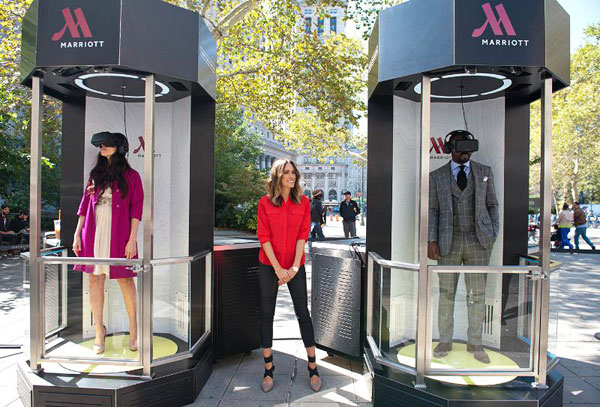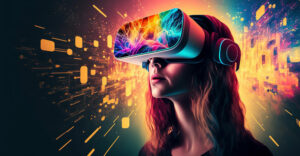Marriott Hotels last week introduced a new vacation opportunity: instant teleportation from New York City to the beaches of Hawaii or downtown London — no uncomfortable airplane trip required. The journeys are virtual, using 4D sensory technology based on Oculus Rift.
Travel enthusiasts are able to see, hear and even feel what it’s like to be present in locales halfway across the globe by stepping into a Teleporter — a phone booth-style structure equipped with the Oculus Rift DK2 virtual reality headset, wireless headphones and a suite of on-board 4D sensory elements.
After stepping into the booth and donning the headset, travelers get to see a 360-degree live-action video mixed with photo-realistic CGI elements. They also get to feel the heat, wind or mist characteristic of their vacation spots.
“Hotel guests and members of the public will be able to enter the Teleporter, where they will put on virtual reality headsets and headphones to be completely immersed in a virtual world,” said Lucia Stoller, director of social marketing for Marriott Hotels.
“They will visit a virtual version of a new Marriott Great Room, and from there virtually travel to exciting travel destinations around the world, including Hawaii and London,” she told TechNewsWorld.
“4D elements will kick in, making the experience seem extremely lifelike — like feeling the warm sun on their face, breeze in their hair, the rumble of waves under foot and ocean spray on their face. They’ll also smell lush palm trees, coconut oil and the salty ocean,” added Stoller.
The Teleporter experience will be available through November at eight select Marriott properties in New York, Boston, Washington, D.C., Atlanta, Dallas, San Diego, San Jose and San Francisco,
Trip Previewer
A picture may be worth a thousand words, but the Teleporter is billed as way to get a feel for a destination that photos or video can’t provide. Virtual reality technology may not be meant to replace actual travel but could provide a way to sample a destination to determine where one may want to go.
“VR technology has some very big potential in travel, particularly in ‘try before you buy’ scenarios,” Patrick Moorhead, founder and principal analyst at Moor Insights & Strategy, told TechNewsWorld.
“Hotels could enable potential buyers [to check] out a room before they make a reservation. Consumers could experience the views, the quality and size of the rooms,” he added.
The technology even could be used to upsell services and offerings, suggested Moorhead. “I can see airlines using VR during the seat selection process to incent you to upgrade.”
It could be provided for some higher-end rooms to encourage a getaway, while acting as a training tool for the travel industry.
“We are seeing a lot of potential applications, such as what it means for in-room entertainment,” said Marriott’s Stoller. “Behind the scenes, it’s a great opportunity for training associates how to enhance the guest experience — it’s almost like a dress rehearsal module.”
VR’s Vertical Offerings
There are real world considerations that need to be addressed with virtual reality applications, however.
“Some people feel very weird about wearing this sort of thing on their head,” said Roger Kay, principal analyst at Endpoint Technology Associates. “That would limit the market for potential users.”
Yet there could be specific plays in vertical markets that could make the Teleporter or other VR solutions all the more attractive.
“While the experience could provide those virtual trips on an ad hoc basis, ‘so here is what it is like to be in London,’ there are other visualization applications where this could be more appealing,” Kay told TechNewsWorld. “Architects could use this to show what a house will look like and allow someone to actually walk around in it before it is ever built.”
These specific applications may have limited appeal, but combined there could be enough to spur interest in further development of VR.
“You can think of a dozen ways to use this technology,” Kay offered. “Each market may not be huge, but together it could be a substantial business for the companies involved.”






















































